The Best Food Processor
The Best Food Processors of 2020


Updated May 3, 2020
When you’re cooking up a storm, a large, high-quality food processor is a must-have. In mere seconds, it can chop vegetables or blitz a bunch of parsley into dust, and some can even knead bread dough for you.
If you’ve never used one of these popular kitchen appliances, you may find there's a bit of a learning curve to properly utilize that slicing blade. But once you master the operation, you’ll never again find it too much trouble to slice spuds thinly for scalloped potatoes, shred carrots for salads, or grind peanuts and almonds to make your own nut butters at home.
We've recently re-tested the best food processors and added new products to this guide, which confirms the Cuisinart "Custom 14" DFP-14BCNY (available at Amazon for $183.99) is still the top chopper on the market. It gives top-notch performance without hogging too much kitchen counter space. With 14 cups of capacity, this food chopper is perfect for home cooks. However, if you’re looking for a more stripped-down experience, we've got plenty of other options.
Here are the best food processors we tested ranked, in order:
Cuisinart "Custom 14" DFP-14BCNY Black & Decker FP4200B-T Cuisinart Stainless Steel 13-Cup SFP-13 Breville BFP800XL Sous Chef 16 Pro KitchenAid 14-Cup Food Processor KitchenAid 7-Cup Food Processor Hamilton Beach 70580 Big Mouth Duo Plus Oster Designed for Life 14-Cup Hamilton Beach Stack & Snap Food Processor with Bowl Scraper 70820 Black and Decker FP2500 PowerPro Wide-Mouth
Recommendations are independently chosen by Reviewed’s editors. Purchases you make through our links may earn us a commission.
Black & Decker FP4200B
What is a Food Processor?
What's the Difference Between a Grating Disc and a Slicing Disc?
How Do I Clean a Food Processor?
Other Food Processors We Tested
More Articles You Might Enjoy
Our Favorite Food Processors of 2020


Cuisinart DFP-14BCNY
Excels at every task
Fits under a cabinet
Slightly inconvenient chute lock
Doesn't shred mozzarella evenly

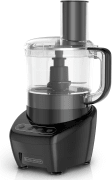
Black & Decker FP4200B
Chops, slices, and kneads dough exceptionally well
All parts dishwasher safe
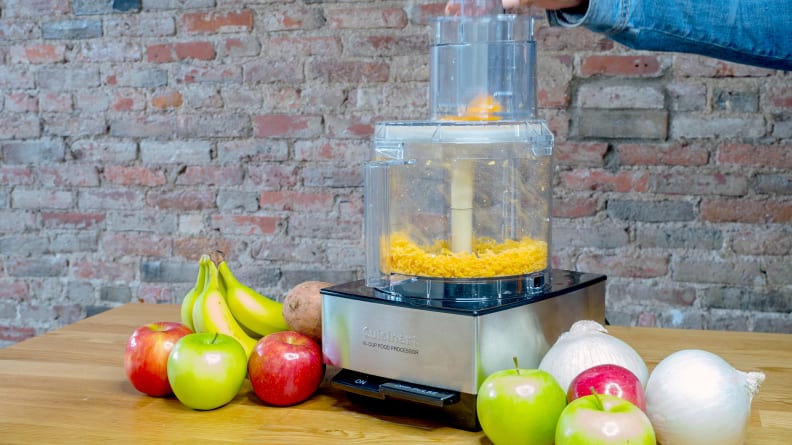

This Cuisinart excelled at almost every task, chopping onions and slicing tomatoes as well as a razor-sharp chefs’ knife, as well as kneading pizza dough into a smooth elastic ball.
Cuisinart was the first food processor sold in the U. S. and, in our opinion, the Cuisinart “Custom 14” is the best on the market today. It excelled at almost every task, chopping onions and slicing tomatoes as well as a razor-sharp chefs’ knife and kneading pizza dough into a smooth elastic ball.
Shredding mozzarella was the only chore at which it faltered. Although it shredded without stalling, like every model we tested it failed to produce shreds evenly.
It’s not small, but the nearly 16-inch tall Cuisinart will fit under a cabinet, and at 17 pounds it isn’t too heavy to move around.
The operation is simple: There are two large levers to press, one to run the processor continuously and then shut it off and one for pulse. In addition to the basic chopping, mixing and dough blade, it comes with shredding and slicing discs. To use the discs, you attach them to a stem that sits in the bowl. Be aware that it’s a little tricky to click them into place.
The food chute locks into place at the rear of the bowl, which is slightly inconvenient when you’re feeding in food but makes it easier to see what’s happening in the bowl during processing. As the tube is large, there’s no need to cut a block of mozzarella or a beefsteak tomato in half before processing them. While it’s running, the Cuisinart is so quiet it won’t shut down conversation in the kitchen.
The Custom 14 is easy to clean: Cuisinart is the only manufacturer that goes beyond just "dishwasher safe" and actually encourages you to wash the parts in the dishwasher. It’s available in white or black with stainless accents or all brushed stainless steel. A disc storage unit, a flat lid, other size shredding and slicing discs, and whisk attachments can be purchased separately.
Excels at every task
Fits under a cabinet
Slightly inconvenient chute lock
Doesn't shred mozzarella evenly
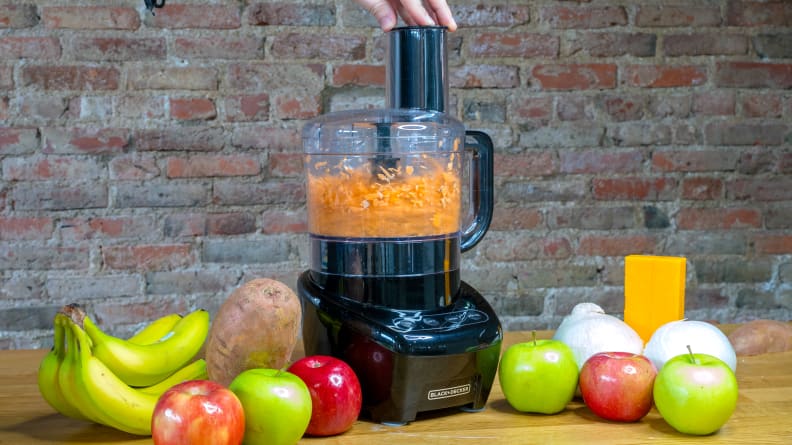

This Black and Decker was also the only one we tested to cut a complete stick of pepperoni into perfectly even rounds.
In spite of its rock bottom price, the Black and Decker 3-in-1 Easy Assembly 8-Cup Food Processor wowed us with its ability to mince, chop, and slice.
During our testing, large ripe tomatoes needed to be cut in quarters to fit into the processor's feed tube, but they still came out in perfectly uniform slices, ready to be arranged around a salad bowl or tucked between slices of mozzarella.
This Black and Decker was even able to knead dough quickly and efficiently without the machine "walking" on the countertop.
The working bowl is particularly easy to position on its base. With this machine, you get only one attachment besides the chopping blade: a reversible slicing and shredding disc that can be stored within the machine. Also, you can pop the parts in the top rack of the dishwasher for easy cleaning.
Chops, slices, and kneads dough exceptionally well
All parts dishwasher safe
Related content

feature
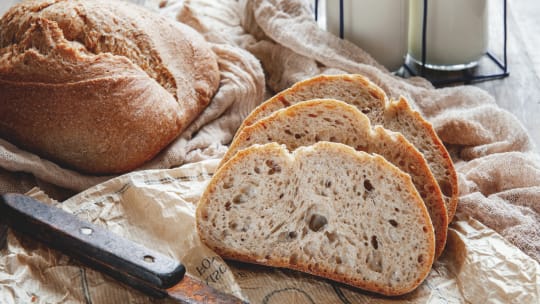
feature
How We Tested
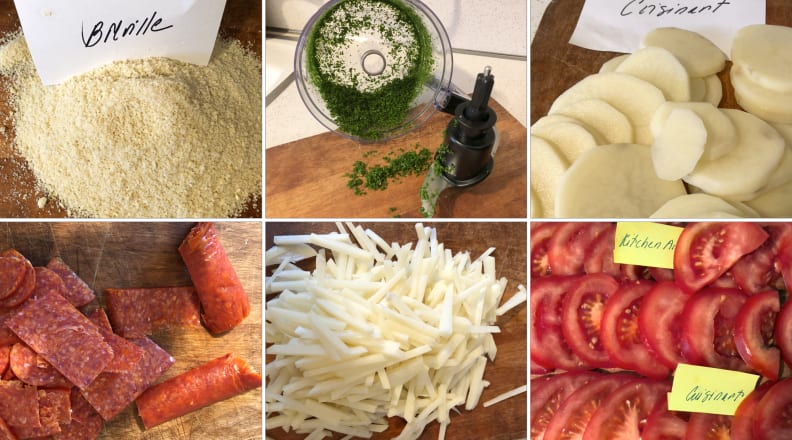
We pulverized, minced, and chopped our way through an awful lot of food while testing food processors. Clockwise starting upper-left: almonds, parsley, sliced potatoes, pepperoni, julienned potatoes and tomatoes. (Not shown but also tested: onions, mozzarella, and pizza dough.)
The Tester
Hi, I'm Sharon Franke, and I’ve been reviewing kitchen equipment for upwards of 30 years. Before that, I worked as a professional chef in New York City restaurants for seven years. Now, most of my cooking is done on weekends in my small apartment kitchen. While I’m a whiz with a knife, I wouldn’t want to live without my food processor for tasks like finely chopping veggies for a tabbouleh or preparing pastry dough for tarts and quiches.
The Tests
To find the best food processors, we first tested seven full-size products over the course of a few weeks. More than a year later, we reevaluated the products and added three more to test, for a total of 10. Each appliance was rated on how well it chopped onions, minced parsley, ground almonds, sliced potatoes, tomatoes, and pepperoni, shredded mozzarella cheese, and cut potatoes into julienne strips. In those that were designed to knead dough, we made pizza dough, too.
Since these machines can be complicated at times—especially if this is your first time food processing—we spent a lot of time poring over each of its manuals. Did it explain how to use the processor thoroughly or did we still have to experiment to determine how to assemble the parts, use the attachments, and process specific foods?
We also considered whether it was easy to lock the lid onto the work bowl and use the controls and how much of a racket it created when running.
While we didn’t include size in our ratings, we took it into consideration as once you see what it can do, you may want to give your food processor a permanent place on your countertop. We also checked whether or not these food choppers include a storage case.
We did not evaluate mini food processors (mini choppers) for this guide, but we'll look to those in the future.
What is a Food Processor?
A food processor is a kitchen appliance that's known for quickly chopping all your vegetables into mini food bits. But it can do more than chop! It mixes, purees, emulsifies, grates, and shreds all your ingredients. There are two main features that set this appliance apart from others in your kitchen—its settings and its blade.
Most food processors come with base settings that include pulse and puree. Pulsing allows you to chop ingredients in short bursts—this is best used when adding large chunks to the processor, as it allows you to chop or puree them down to a manageable size. Even if you're going to eventually puree the ingredients, it’s a good idea to pulse the big pieces first so they don’t get stuck in the blade.
On the other hand, when you puree in your food, the blade blends ingredients continuously. This is the perfect setting for making pesto or tomato sauce. Most processors allow you to control the speed of your puree—typically with high and low settings. A high speed will emulsify your ingredients more, while a low speed will leave you with chunkier bits.
High-end models may also come with more advanced chopping options, but for the most part, these standard settings work perfectly. It's more important to have a powerful model, which is one of the key aspects we tested in this guide.
What's the Difference Between a Grating Disc and a Slicing Disc?
Food processors have a removable blade, which not only makes cleaning much easier but allows you to use a variety of specific attachments. You’ll want to use your standard blade for pulsing and pureeing, but the following are two common attachments that are helpful for other food prep.
Grating Disc: A grating attachment works well for items like carrots, potatoes, and cheese. To use it, remove the standard blade and place the grating disc on the middle spoke in your processor. Reattach the lid, then remove the pusher from the feed tube—that's the little "chimney" that allows you to drop ingredients into the processor. Hold the pulse button and add your ingredients. You should use the pusher to press your ingredient further into the processor. Do not use your fingers!
Slicing Disc: To slice an ingredient, follow the same steps as grating, but use the attachment that has a thin slicing line across it. You can use this attachment to shave Brussels sprouts, make potato gratin or slice up other vegetables.
How to use a food processor
It can do everything short of actually cooking your dish. Here are some quick tips on how to use it to its fullest potential.
- Chop dry ingredients: Use the pulse feature to chop larger foods into small pieces. Press and release the button until you've reached the desired size. This can be done to anything from onions and carrots to nuts. Puree wet ingredients: Use the puree setting to combine wet and dry ingredients and create an emulsified consistency. Hummus, for example, is easy to make in your processor. Mix and blend ingredients: Remember when we were talking about pastries? Your processor isn’t limited to savory dishes—you can make cookie or pastry dough or knead bread dough in your processor, as the blades can chop and blend cold butter into dry ingredients. Don't mash potatoes: Please don’t mash potatoes in your food processor. Chop, shred or grate raw spuds, but don’t use the appliance on cooked potatoes. When you use a sharp blade to mash potatoes, it breaks down the enzymes in the cooked vegetable and makes them unstable. This leads to gluey potatoes and very sad spirits.
How Do I Clean a Food Processor?
There’s good news and bad news. The bad news is that food processors can take some work to clean. There are a lot of pieces to remove and soak, and some components have nooks and crannies that are difficult to fully clean. There are a few easy-to-clean models available if you're not one for careful scrubbing.
The good news, however, is that all the pieces are removable, and many can go in the dishwasher.
Other Food Processors We Tested

Another good choice for a large chopper to perform a variety of cooking prep chores is the Cuisinart Stainless Steel 13-Cup Food Processor. It's just one cup smaller in capacity than our top pick.
It too can be relied upon to cut cleanly and give even results whether you’re slicing potatoes for an au gratin, mincing herbs, or kneading pizza dough. The feed tube is large enough to hold a block of mozzarella but can be adjusted to be thin enough to accommodate a pepperoni.
To operate this machine, you must be sure to align all the parts, but it’s easy to quickly get the hang of it and they turn and lock into place smoothly. And unlike the larger Cuisinart, the feed tube is in the front, making it easier to add food.
With this model you get both a large 13-cup bowl and a smaller 4 ½-cup one, chopping and kneading blades, a slicing disc that adjusts for 7 different thicknesses, a shredding disc that reverses for thin or thick shreds, and a plastic spatula.
A case to corral all the accessories is also included but that means you have to find storage space to keep it, too. Dicing and spiralizer accessories are available and they work well but they do have lots of small parts that you also have to assemble and store when you’re not using them. As long as you find room in the top rack, all of the parts are dishwasher safe.
Комментарии
Отправить комментарий